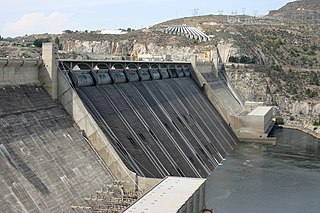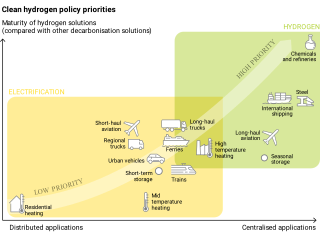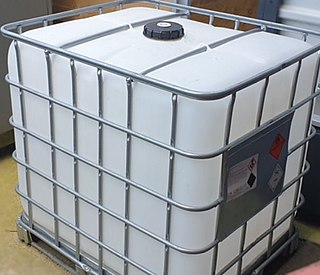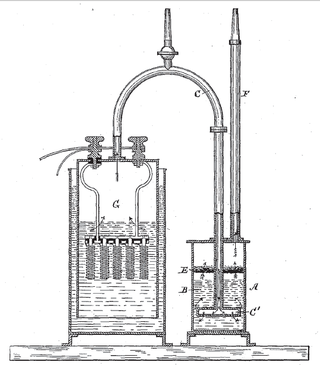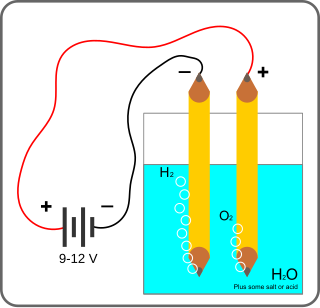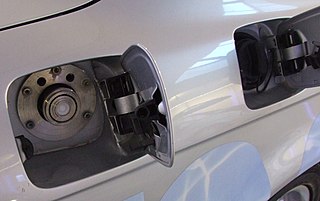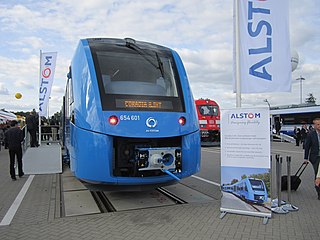Claims of functioning water-fuelled cars
Garrett electrolytic carburetor
Charles H. Garrett allegedly demonstrated a water-fuelled car "for several minutes", which was reported on September 8, 1935, in The Dallas Morning News. [8] The car generated hydrogen by electrolysis as can be seen by examining Garrett's patent, issued that same year. [9] This patent includes drawings which show a carburetor similar to an ordinary float-type carburetor but with electrolysis plates in the lower portion, and where the float is used to maintain the level of the water. Garrett's patent fails to identify a new source of energy.
Stanley Meyer's water fuel cell

At least as far back as 1980, Stanley Meyer claimed that he had built a dune buggy that ran on water, [11] although he gave inconsistent explanations as to its mode of operation. In some cases, he claimed that he had replaced the spark plugs with a "water splitter", [12] while in other cases it was claimed to rely on a "fuel cell" that split the water into hydrogen and oxygen. The "fuel cell", which he claimed was subjected to an electrical resonance, would split the water mist into hydrogen and oxygen gas, which would then be combusted back into water vapour in a conventional internal combustion engine to produce net energy. Meyer's claims were never independently verified, and in an Ohio court in 1996 he was found guilty of "gross and egregious fraud". [1] He died of an aneurysm in 1998, although conspiracy theories claim that he was poisoned. [6]
Dennis Klein
In 2002, the firm Hydrogen Technology Applications patented an electrolyser design and trademarked the term "Aquygen" to refer to the hydrogen oxygen gas mixture produced by the device. [13] [14] [15] Originally developed as an alternative to oxyacetylene welding, the company claimed to be able to run a vehicle exclusively on water, via the production of "Aquygen", and invoked an unproven state of matter called "magnegases" and a discredited theory about magnecules to explain their results. [16] Company founder Dennis Klein claimed to be in negotiations with a major US auto manufacturer and that the US government wanted to produce Hummers that used his technology. [17]
At present, the company no longer claims it can run a car exclusively on water, and is instead marketing "Aquygen" production as a technique to increase fuel efficiency, [18] thus making it Hydrogen fuel enhancement rather than a water-fuelled car.
Genesis World Energy (GWE)
Also in 2002, Genesis World Energy announced a market ready device which would extract energy from water by separating the hydrogen and oxygen and then recombining them. [19] In 2003, the company announced that this technology had been adapted to power automobiles. [20] The company collected over $2.5 million from investors, but none of their devices were ever brought to market. In 2006, Patrick Kelly, the owner of Genesis World Energy was sentenced in New Jersey to five years in prison for theft and ordered to pay $400,000 in restitution. [21]
Genepax Water Energy System
In June 2008, Japanese company Genepax unveiled a car it claimed ran on only water and air, [22] and many news outlets dubbed the vehicle a "water-fuel car". [23] The company said it "cannot [reveal] the core part of this invention" yet, [24] but it disclosed that the system used an onboard energy generator, which it called a "membrane electrode assembly", to extract the hydrogen using a "mechanism which is similar to the method in which hydrogen is produced by a reaction of metal hydride and water". [25] The hydrogen was then used to generate energy to run the car. This led to speculation that the metal hydride is consumed in the process and is the ultimate source of the car's energy, making it a hydride-fuelled "hydrogen on demand" vehicle rather than water-fuelled as claimed. [26] [27] [28] On the company's website the energy source is explained only with the words "Chemical reaction". [29] The science and technology magazine Popular Mechanics described Genepax's claims as "rubbish". [30] The vehicle Genepax demonstrated to the press in 2008 was a REVAi electric car, which was manufactured in India and sold in the UK as the G-Wiz.[ citation needed ]
In early 2009, Genepax announced they were closing their website, citing large development costs. [31]
Thushara Priyamal Edirisinghe
Also in 2008, Sri Lankan news sources reported that Thushara Priyamal Edirisinghe claimed to drive a water-fuelled car about 300 km (190 miles). [32] on 3 litres (5.3 imperial pints) of water. [33] [34] Like other alleged water-fuelled cars described above, energy for the car was supposedly produced by splitting water into hydrogen and oxygen using electrolysis, and then burning the gases in the engine. Thushara showed the technology to Prime Minister Ratnasiri Wickramanayaka, who "extended the Government’s full support to his efforts to introduce the water-powered car to the Sri Lankan market". [33] Thushara was arrested a few months later on suspicion of investment fraud. [4]
Daniel Dingel
Daniel Dingel, a Filipino inventor, has been claiming since 1969 to have developed technology allowing water to be used as fuel. In 2000, Dingel entered into a business partnership with Formosa Plastics Group to further develop the technology. In 2008, Formosa Plastics successfully sued Dingel for fraud and Dingel, who was 82, was sentenced to 20 years' imprisonment. [3]
Ghulam Sarwar
In December 2011, Ghulam Sarwar claimed he had invented a car that ran only on water. At the time the invented car was claimed to use 60% water and 40% Diesel or fuel, but that the inventor was working to make it run on only water, probably by end of June 2012. It was further claimed the car "emits only oxygen rather than the usual carbon". [35]
Agha Waqar Ahmad
Pakistani man Agha Waqar Ahmad claimed in July 2012 to have invented a water-fuelled car by installing a "water kit" for all kind of automobiles, [36] [37] which consists of a cylindrical jar that holds the water, a bubbler, and a pipe leading to the engine. He claimed the kit used electrolysis to convert water into "HHO", which is then used as fuel. The kit required use of distilled water to work. [38] Ahmed claimed he has been able to generate more oxyhydrogen than any other inventor because of "undisclosed calculations". [39] He applied for a patent in Pakistan. [39] Some Pakistani scientists said Agha's invention was a fraud that violates the laws of thermodynamics. [40]
Aryanto Misel
Indonesian inventor Aryanto Misel claimed in May 2022 that his invention, called Nikuba, can convert water into hydrogen that can be used as fuel for motorcycles. Aryanto claimed that he only required 1 liter of water for the distance of 500 kilometers. [41]
In July 2023, Aryanto claimed that Italian-based automobile manufacturers Lamborghini, Ducati, and Ferrari are interested in Nikuba. [42] He also claimed that he is willing to sell the device to foreign companies for 15 billion rupiahs, while also claiming that he didn't need the Indonesian government and National Research and Innovation Agency as they have "destroyed" him. [43] [44] Indonesian scientists from National Research and Innovation Agency stated that the device is theoretically impossible. [45] They also stated that there is no interest from Italian automobile manufacturers in Nikuba, and Aryanto was invited by their partners instead of the automobile manufacturers. [46]






